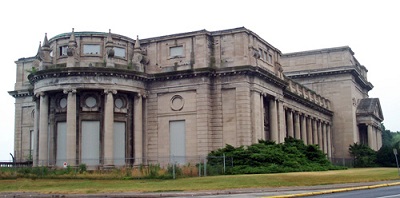Toronto Power Generating Station National Historic Site of Canada
Niagara Falls, Ontario

Side view
© Parks Canada Agency / Agence Parcs Canada, 2005.
Address :
7230 Niagara Parkway, Niagara Falls, Ontario
Recognition Statute:
Historic Sites and Monuments Act (R.S.C., 1985, c. H-4)
Designation Date:
1983-11-18
Dates:
-
1903 to 1913
(Construction)
Event, Person, Organization:
-
Electrical Development Company
(Organization)
-
Edward James Lennox
(Architect)
Other Name(s):
-
Toronto Power Generating Station
(Designation Name)
-
Electrical Development Company Generating Station and Powerhouse
(Other Name)
Research Report Number:
1992-054
Plaque(s)
Existing plaque: 7230 Niagara Parkway, Niagara Falls, Ontario
Opened in 1906 to supply the Toronto market, this generating station was the first wholly Canadian-owned hydro-electric facility at Niagara Falls. Engineers adapted advanced European and American technologies to a difficult site in a bold and enterprising way. The station's palatial powerhouse was designed by the eminent Toronto architect E. J. Lennox to complement the scenic setting. Symmetrical, colonnaded and faced in limestone, it is an early and unusual application of Beaux-Arts design to an industrial site in Canada. Purchased by Ontario Hydro in 1922, the station operated until 1974.
Description of Historic Place
The Toronto Power Generating Station National Historic Site of Canada is located on the banks of the Niagara River just above Niagara Falls. The Power House is a rectangular building measuring 132 metres by 30 metres with an imposing classical façade. Its symmetrical plan consists of a central block with a heavy Ionic portico flanked by two long Ionic colonnades. The Power House contains the generators and stands above the other principal engineering components of the installation that include a submerged dam, penstocks, and the wheel pit housing the turbines, and the tailrace tunnel. Official recognition refers to the building and structures on the legal lot at the time of designation (1983).
Heritage Value
The Toronto Power Generating Station was designated a national historic site of Canada because: this generating station was the first wholly Canadian-owned hydro-electric facility at Niagara Falls; the powerhouse is an early and unusual application of Beaux-Arts design to an industrial site in Canada.
The Toronto Power Generating Station, associated with development of hydro-electric power in Canada, was a significant large-scale engineering achievement in its time and was important in the development of business, industry and technology in Ontario and Canada. The Generating Station and Power House was built for the Electrical Development Company of Ontario to supply hydro-electric power to Toronto. The installation was begun in 1903 with the Power House designed in the formal Beaux-Arts style by architect E.J. Lennox to complement the majestic setting. The Toronto Power Generating Station was opened in 1906, and was purchased by Ontario Hydro in 1922. It operated until 1974.
Source: Historic Sites and Monuments Board of Canada, Minutes, November 1992.
Character-Defining Elements
The key elements that contribute to the heritage character of this site include: the prominent location on the bank of the Niagara River above the Niagara Falls; the river-front setting with the building as a component of a scenic, landscaped public parkland; the large, flat-roofed, symmetrical massing; the steel-frame construction clad in brick and Indiana limestone; the classical Beaux-Arts style main west façade that includes a projecting central block with a heavy Ionic portico flanked by two long Ionic colonnades; the austere east, rear elevation facing the river that is faced with plain terracotta brick and simply decorated with a row of shallow strip pilasters; the regularly placed windows, and the large bow window across the north elevation; the Power House’s interior configuration, features and finishes, including the central entrance, the grand foyer finished with marble walls and floor tiles, the enriched cornices, and the elaborated architraves; the configuration, features and finishes of the work room, public waiting room and board room, and also the glazed industrial brick of the generator room; the principal engineering components of the installation that include a submerged dam, penstocks, the wheel pit housing the turbines, the tailrace tunnel and the power house with generators.